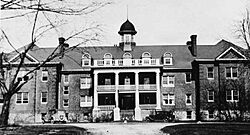Mohawk Institute Residential School facts for kids
Quick facts for kids Mohawk Institute Residential School |
|
|---|---|

The Mohawk Institute c. 1932.
|
|
| Location | |
|
Brantford, Ontario
|
|
| Coordinates | 43°07′39″N 80°14′25″W / 43.12760°N 80.24039°W |
| Information | |
| Type | Canadian Indian residential school |
| Established | 1828 |
| Closed | 27 June 1970 |
| Principal | see § Principals |
| Enrolment | 90 to 200 |
| Language | English |
The Mohawk Institute Residential School was a type of school in Brantford, Ontario, Canada. It was part of the Canadian Indian residential school system. This system sent Indigenous children to schools far from their homes. The Mohawk Institute was open from 1831 until June 27, 1970. Each year, between 90 and 200 students attended the school.
Contents
History of the Mohawk Institute
Early Years and Management
The school started in 1828 as the "Mechanics' Institute." It was a day school for boys on the Six Nations of the Grand River reserve. The Society for the Propagation of the Gospel in New England ran the school. This group was also known as the New England Company.
In 1831, it became a residential school for boys. By 1834, Indigenous girls also started attending. Students came from Six Nations and other nearby communities. These included New Credit, Moraviantown, Sarnia, and Walpole Island. Others came from Muncey, Scugog, Stoney Point, Saugeen, Bay of Quinte, and Kahnawake reserves.
The school was built on 350 acres of farmland. This land was once part of the Six Nations reserve.
Changes and Rebuilding
The school was first located near the Mohawk village. In 1837, the government told Six Nations people to move. They had to resettle south of the Grand River, far from the school.
Between 1854 and 1859, the school building burned down. It was rebuilt a short distance from its original spot. Around this time, the school got more land. Farming became a very important part of daily life for the children. In 1885, the school began to accept students from reserves beyond Six Nations.
On April 19, 1903, the main school building was destroyed by fire again. In May, the barns also burned down. In June, a playhouse used as a boys' dorm was also lost to fire. The school buildings were rebuilt the next year. The new building had separate areas for boys and girls. It also had rooms for the principal and teachers, plus offices. This new school was designed for 150 students. New farm buildings were also added.
Government Control and Closure
In 1922, the Canadian federal government officially took over running the school. However, the New England Company still owned the building. The agreement said the principal had to be Anglican. A chapel was added to the school in 1930. By 1955, 185 children were enrolled.
In 1963, farming stopped at the school. Children then spent their full day on education. They no longer had to do manual labour. Fewer children attended the Mohawk Institute as new schools opened on reserves across Ontario. In 1970, the school closed its doors. The Six Nations community took ownership of the building the following year.
Principals of the School
The people listed below were the principals of the Mohawk Institute during its time open:
| Principal Name | Years |
|---|---|
| Rev. Abraham Nelles | 1831-1870 |
| Rev. Robert Ashton (Also Chaplain of Mohawk Chapel from 1885-1915) | 1870-1903 |
| Major Alfred Nelles Ashton (son of Robert Ashton) | 1903-1914 |
| Alice M. Boyce (Acting Principal) | 1914-1915 |
| Rev. Cyril M. Turnell | 1915-1918 |
| Alice. M. Boyce | 1918-1922 |
| Sydney Rogers | 1922-1929 |
| Rev. Horace W. Snell (Also Chaplain of Mohawk Chapel) | 1929-1945 |
| Rev. William John Zimmerman (Principal/Administrator and Chaplain of Mohawk Chapel) | 1945-1970 |
The Mohawk Institute Today
After the Mohawk Institute closed in 1970, the Woodland Cultural Centre opened there in 1972. This center focuses on research, history, and the arts. The Woodland Cultural Centre uses the old Mohawk Institute building. They teach people about the history of residential schools in Canada.
In 2013, the roof of the building leaked. This caused a lot of damage. The Six Nations of the Grand River community then decided what to do with the building. Most people (98%) voted to save the historic building. In March 2014, the "Save the Evidence" campaign began. This campaign raises money to fix the Mohawk Institute. It also helps people learn about the history of residential schools.
In 2021, unmarked graves were found at the Kamloops Indian Residential School in British Columbia. After this, the chief of Six Nations of the Grand River, Mark Hill, asked the Canadian government for help. He asked them to support a search for missing children. These children might have been buried on the Mohawk Institute's grounds.
Legacy and Impact
The experiences of students at the Mohawk Institute have inspired many artists and writers. Their stories help us understand this important part of history.
- "Mush Hole Remembered: R.G. Miller" is a series of paintings. Artist R.G. Miller created them based on his time as a student at the Mohawk Institute.
- "Opening Doors to Dialogue" was a community art project. Samuel Thomas and the Woodland Cultural Centre led it. They used the Mohawk Institute building to inspire talks, healing, and art in the community.
See also


